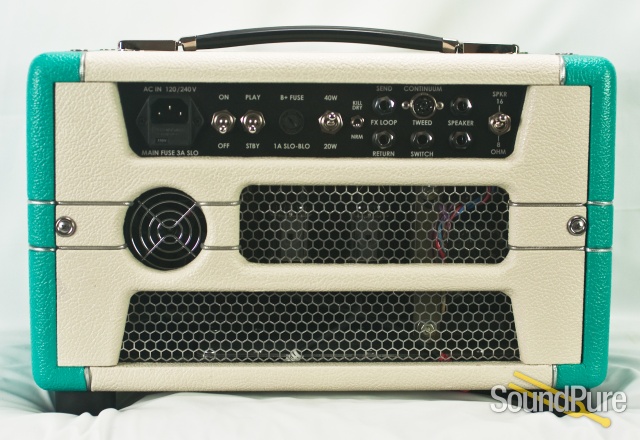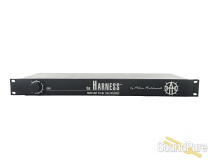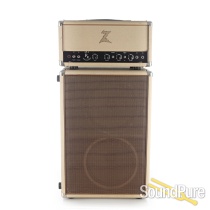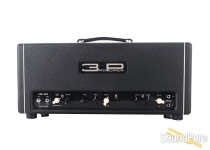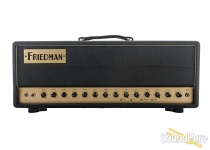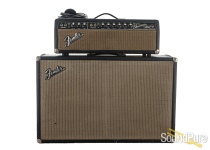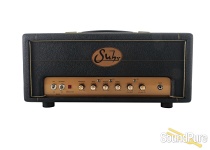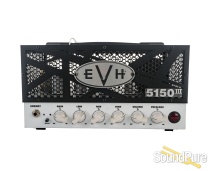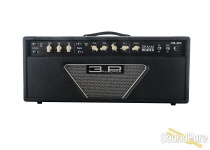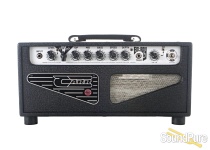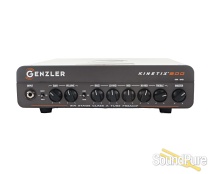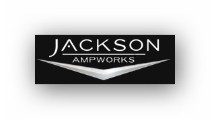-
Call Us Toll Free888-528-9703
-
Local/International (+1)919-682-5552
- Call Us! Toll Free! 888-528-9703
- Local / International (+1) 919-682-5552

Jackson Ampworks Fullerton Amp Head - Ivory & Teal From Jackson Ampworks
Jackson's version of the Princeton Reverb on steroids!
Available for Special Order
See something you like? This item is gone, but not forever. It can be special ordered, and even customized!
We can get it fast!
Because of our special relationship with Jackson Ampworks we can get this as fast, or faster than anyone in the industry. In some cases, we even have preferred build slots we can offer you.
Want to know when one lands?
Notify MeWant to discuss a special order?
What We Think
Jackson put a lot of thought into their updated version of the beloved Fender Princeton Reverb and it shows. I sat down with this amp today and was simply thrilled by it. By bumping the output up from 20W to 40W, they've increased the amount of headroom and volume available with added clarity and focus that the original couldn't deliver. And if you want to get more of that vintage vibe, they've provided a Half Power Switch that allows you to dial it back down to 20W. Genius! They've also thrown a Tweed knob into the mix, allowing you to add even more gain if desired. I really enjoyed experimenting with the Three Knob Spring Reverb, which gives you complete control over Send and Return levels, as well as overall Reverb Tone. Talk about versatile! The Jackson Fullerton takes an incredible amp and updates it with modern features you're sure to love!
Manufacturer's Description from Jackson Ampworks
DESIGN GOALS.
When the team and I set out to make the Fullerton in the spring of 2014 (exactly 50 years after the release of the Princeton Reverb in 1964), we wanted to create an 6V6 style American Voiced amp that would pay homage to the venerable Princeton Reverb, but would also pick up where the Princeton left off and bring that core tone into the modern era with refinements that only 50 years of technological advancement can provide.
In order to build a better amp we had to ask ourselves, “What made the Princeton so great, and how can we make it better?” In order to answer that question, we had to identify the core qualities of the Princeton Reverb that have kept it at the forefront of popular music for over 50 years. The Princeton Reverb, which is the most recorded amplifier in history, has a number of qualities that have helped it stand the test of time. Those traits are namely, a fantastic core tone, legendary lush reverb, raw and organic tremolo and a small form factor which makes it perfect for gigging.
In order to improve on the Princeton, we chose to focus on the very things that made the Princeton a legend and systematically improve upon each of them with a radically expanded set of features that Leo and the boys could have only dreamed about 50 years ago!
Keep reading below as we go through every feature of the Fullerton and learn the story of how the Fullerton became our tribute to the greatest amplifier designer of all time, Clarence “Leo” Fender.
MORE POWER
If the Princeton Reverb has one complaint, it is that it is not powerful enough to remain clean at loud stage volumes. With this in mind we opted to double the number of 6V6 output tubes in the Fullerton from 2 to 4, and in so doing doubled the maximum power of the Fullerton to 40W! This increased power, along with our custom wound 200W output transformer, will deliver more volume, headroom and low end punch than you’ve ever heard from a Princeton Reverb! Low notes that typically can “flub out” on a Princeton will remain crisp, tight and focused as the extra wattage works to deliver your tone with unparalleled clarity and definition. We have also included a Half Power Switch on the back of the amplifier so you can adjust the output power from 40W down to 20W.
REVERB…REINVENTED.
To improve on the single knob reverb of the Princeton, we expanded it to a full featured Tube Driven Three Knob Spring Reverb like you’d find on an outboard reverb unit! With the Fullerton it’s like you have an outboard spring reverb unit integrated into the amp! The Fullerton reverb has three controls; Reverb Send (R.SND), Reverb Tone (R.TONE) and Reverb Return (R.RTN). The Reverb Send allows you to set how hard the reverb tank is being driven by the preamp. Lower settings of the Reverb Send control will give a more subtle sounding reverb while higher settings will give a more pronounced or “surf” style of reverb. The Reverb Tone control allows you to adjust the tone of the reverb from very warm and plate-like in the lower settings, to very bright and crisp (like you’d hear in some of Eric Johnson’s earlier recordings) in the higher settings. Finally, the Reverb Return control adjusts the amount of reverberated signal that is mixed back into your dry signal. Experiment with various ratios of Reverb Send to Reverb Return and you’ll find a host of new reverb tones waiting in there!
The Reverb feature of the Fullerton is the first logical place to introduce the Continuum Controller™, our optional Reverb/Tap Tempo Tremolo Controller. We’ll get to the Tremolo functions of the Continuum Controller later, but this unit is a foot controller that allows control over the Reverb Return level by way of its REVERB control as well as providing a remote ON/OFF for the Reverb. You’ll notice that when you activate the Reverb footswitch on the Continuum Controller that the indicator light on the front panel switches from White to Blue. Furthermore, the Reverb Return level can also be adjusted by plugging an expression pedal into the 1/4″ jack on the back of the Continuum Controller labeled REVERB. For the first time ever, you can now adjust the spring reverb on your amp remotely using the Continuum Controller as well as have instantaneous control over it using an expression pedal! TIP! Try using the expression pedal to add extra reverb to parts of the song you want to stand out more or during solos to make certain notes jump out! Note: When the Continuum Controller is plugged into the Fullerton, the Reverb Return (R.RTN) control on the front of the amplifier is inactive as the Continuum Controller takes priority.
We are beyond proud of the Reverb we have designed into the Fullerton and feel that it is a worthy successor to the legendary reverb that Leo developed over 50 years ago.
TAP TEMPO BIAS TREMOLO
In the world of amplifier tremolos, there are three main types and each type has its own sound. The first type is called “bias tremolo” and in addition to being used on Princeton Reverb was the first tremolo type to be used in guitar amplifiers. Bias tremolo is characterized by having a swampy, organic and raw tonality that most people agree has a ton of vibe to it. The second tremolo type is called “optical tremolo” which is characterized by being very staccato and choppy. Lastly, the third type is called “harmonic tremolo” and is the most advanced of all the tremolos and produces a sound that to many ears has more in common with a UniVibe than a tremolo.
When used with the optional Continuum Controller, the Fullerton and the Bakersfield are the first amplifiers ever made that feature Tap Tempo Bias Tremolo! This type of tremolo is unique among the three types of tremolo in that it is the only one that uses a Digital Low-Frequency Oscillator (LFO) to turn the output tubes on and off with the rise of fall of the LFO thereby creating the tremolo effect.
The Continuum Controller features 7 waveform shapes to let you select which style of LFO you want and is selectable using the 7 position rotary switch. From left to right those waveforms are, Lumps, Sweep, Sine, Triangle, Square, Ramp Down, Ramp Up. You’ll find that each waveform will produce a different feel so experiment to find which waveform best suits the feel of the song you are playing. For instance, the Square wave is very staccato and can be heard on songs such as The Smiths – How Soon Is Now. The Sine wave, on the other hand, is a smoother sounding waveform and is characteristic of this tone you’d hear on Creedence’s – Born On The Bayou.
The Continuum Controller also has a 6 position rotary switch allows you to select the ratio or multiplier of the Tap footswitch. From left to right those ratios are, Half Notes, Quarter Notes, Quarter Note Triplets, Eighth Notes, Eighth Note Triplets and Sixteenth Notes. For instance if you tap quarter notes on the Tap footswitch and have the Ratio control set to Eighth Notes, the tremolo speed with be exactly twice as fast as the tempo you just tapped and likewise if the Ratio control is set to Sixteenth Notes the tremolo speed will be exactly 4 times as fast as the tempo you just tapped.
In addition to the tapping the Tap footswitch to set the tempo of the tremolo, the Continuum Controller has a Speed knob that you can set manually. The Speed control also has a dedicated expression jack on the back panel so you can ramp your tremolo speed up and down as you play for Leslie Organ type accents. Also on the rear panel or the Continuum Controller is an expression jack labeled Tap. This jack is a bi-directional Tap In/Out and can send a tap signal to other devices or receive a tap signal from other devices. This becomes very convenient when you have multiple time-based effects on your pedalboard and you only want to tap one button to sync all of them to the beat of the song.
Finally, the Continuum Controller has Depth control which allows you to set the mix of dry signal to tremolo signal. Use this control to dial in a very subtle tremolo in the lower positions or a very distinct tremolo in the upper position. Note: Notice that the Depth control adjusts the intensity of the indicator on the front panel of the amplifier. When the tremolo is switched to the ON position using the Tremolo footswitch, the indicator light on the front panel of the amplifier will start flashing in time with the LFO. The higher the position of the Depth control, the more distinct the flashing will become. Note that the indicator light will pulse with the same shape as the waveform that has been selected! The Depth control also has a dedicated expression jack on the back panel so you can fade in your tremolo signal for seamless dynamic changes.
Finally as we were working through the Continuum Controller we had the idea that wouldn’t it be great if we could take the LFO from the Tremolo circuit and apply it to the Reverb signal. Well, we did just that and results are outstanding! This feature which we are calling Modulated Reverb is accessed by flipping the toggle switch located in the middle of the Continuum Controller upward. In this position the LFO is no longer turning the output tubes On/Off with the rise and fall of the LFO but rather doing the same thing to the Reverb signal. So imagine if you will that your dry signal is remaining constant, but now your reverb is ramping up and down with the speed and shape of the LFO! It sounds like you are playing with two amps, one set for dry (no reverb) and the other set super wet with the tremolo active! You can also select the waveform you’d like to apply to the Modulated Reverb by selecting any of the 7 positions on the Wave control.
We have been working for over a year to perfect the world’s first tap tempo bias tremolo and we feel that the hard work has really paid off. There’s never been an amp made that is like the Fullerton and we hope that once you get a chance to hear it and play it that you’ll agree!
TONE CONTROLS.
To make the Fullerton more flexible, we did away with the normal Treble and Bass control and added a Three Band EQ featuring a Treble, Middle and Bass control. For years guys have been modding their Princeton’s to adjust the “preset” middle control that was set internally in the amp. By giving you a Middle control, you can adjust the amp to find your personal sweet spot. Note: For you Princeton purists, we have tailored the tone controls on the Fullerton so that when the Middle control is straight up at the 12:00 position, that is the stock Princeton Reverb middle position and you can cut or boost the mid frequencies from there.
If you’re familiar with most Fender amps, they have a bright switch which is used to boost the high frequencies in the amp. Well the issue with most bright switches that I’ve encountered in the past is that the amp is either too dark without the bright switch or its too bright with it on. To solve this dilemma, we have permanently wired in a bright cap (the bright switch enables/disables this cap) and included a master Tone control for the Fullerton. With the bright cap in place the amp can be very bright with the Tone knob set fully clockwise and very dark with it set counter-clockwise or anywhere in between. The addition of the master Tone control allows you to dial in the level of highs you want and tailor your sound for each guitar you play.
To round out the feature set on what is traditionally considered a clean platform, we created a new feature called the Tweed control. The Tweed control is a variable tone stack bypass that lifts the EQ network so that you get back all the gain you lost by going through the EQ controls. When set fully counter-clockwise, the boost is deactivated and the amp is very clean and spanky like you’d expect an American style amp to be. As you roll the Tweed knob up you’ll notice that you have more preamp gain to play with and the notes getting a little hair on them. The higher you go on the Tweed control the more aggressive the boost until you’re all the way up on the Tweed control and you find yourself holding a tiger by the tail! When the Tweed control is wide open you’ll have more than enough gain for soloing and one of the best crunch rhythm sounds you’ve ever heard! We guarantee you’ve never heard a Princeton sound like this before! To make the Tweed control useful as a solo boost, we have designed in a foot-switchable relay that will switch you from fully off to wherever you have the Tweed control set! This makes for an incredible solo boost or is useful for times when you want to punch out of the mix for signature parts! Note: When the included footswitch is plugged in and boost is selected, the indicator on the front panel of the amplifier will turn Red to indicate that the Tweed control is active.
CONCLUSION
The Fullerton has been the most challenging amp we have ever undertaken and features technology never before seen in any guitar amplifier. There are many novel and patented technologies that we have had to develop over the past year to bring the Fullerton to fruition and I feel the end result more than outweighs the cost as well as the blood sweat and tears the entire team has shed in getting this product ready for market. We very much hope you will get a chance to try out the Fullerton for yourself and once you do, please let us know what you think. We’d love to have your feedback!
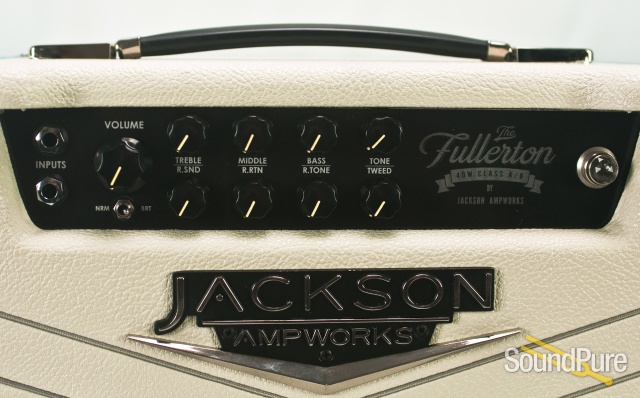
About Manufacturer
Jackson Ampworks is a small boutique amplifier shop located just north of Fort Worth, TX. Our daily focus is to deliver the best sounding, most reliable and musical sounding instruments possible that inspire the player to greater heights in his/her craft. We are very blessed to have been growing continually since we began full time operations just over 3 years ago. This growth, during one of the worst economic climates in US history, is largely due to our loyal customers and dealers without whom we would not be in operation today.
Sound Pure is excited to bring Brad Jackson and the wonderful people at Jackson Ampworks to our inventory and we think you'll drool once you hear some of these rigs!
Specifications
Output Power:
20W - 2x - 6V6 Fixed Bias
40W - 2x - 6V6 Fixed Bias
Tubes:
Preamp 2x 12AX7 1x 12AT7
Phase Inverter 1x 12AX7
Output 4x - 6V6
Rectifier Solid State
Input Impedance 1MΩ
Weight:
Head Cabinet - 35lbs. Boxed
1x12 Combo - 50lbs Boxed
Size:
Head Size: 14" x 8.5" x 8.25"
Head Size (Boxed): 19.5" x 13.5" x 14"
1x12 Combo Size: 18.5" x 10.5" x 17.5"
1x12 Combo Size (Boxed): 22.5" x 14.5" x 21.5"
Line Voltage:
120VAC or 240VAC, Switchable via Back Panel
